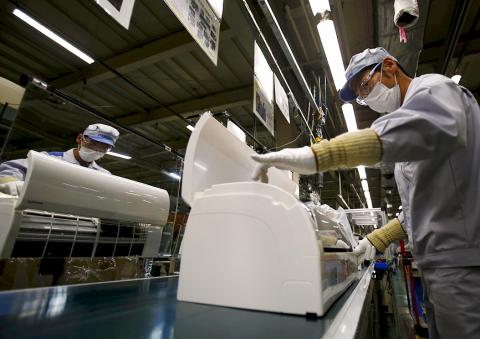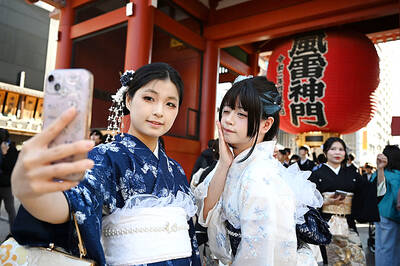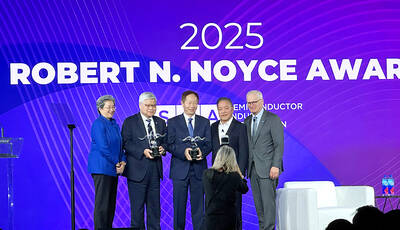Hirotoshi Ogura, a self-described “factory geek,” is Daikin Industries Ltd’s master of doing more with less — and part of the reason Japan’s recovery remains stuck in the slow lane.
As Japan heads into the season of peak demand for room air-conditioners, Ogura and other Daikin managers have been tasked with figuring out how to boost output by about 20 percent at a plant in western Japan that six years ago the company had almost given up on as unprofitable.
The wrinkle: They have no budget for new capital investment at the 45-year-old Kusatsu plant. The still-evolving workaround shown to a recent visitor involves home-made robots for ferrying parts, experimental systems using gravity rather than electricity to power parts of the line, more temporary workers on seasonal contracts and dozens of steps to chip away at the 1.63 hours it takes to make a typical new air conditioner.

Photo: Reuters
“We can do a lot without spending anything,” says Ogura, a 33-year Daikin veteran who joined the company just after high school. “Anything we need, we first try to build ourselves.”
Like Daikin, a number of Japanese manufacturers are shifting production back to Japan from China and elsewhere to take advantage of a weaker yen. Rival Panasonic Corp has pulled back some production of room air-conditioners, Sharp Corp has brought back production of some refrigerators, and Canon Inc has repatriated some output of high-end copiers, according to a list compiled by Nomura.
However, even as output recovers, Japanese companies remain cautious about new capital investment in factories and equipment. The trend is especially pronounced for smaller firms down the supply chain.
After increasing capital spending by 6 percent in the just-completed fiscal year, small manufacturers plan a 14 percent decrease in the current year, according to the Bank of Japan’s (BOJ) quarterly survey released last week. Big manufacturers like Daikin plan a 5 percent increase, but overall investment remains 10 percent below pre-crisis 2007 levels.
Over the same period, corporate earnings have increased by 11 percent, shares have rallied — Daikin’s are up more than four-fold from its 2008 low — and Japanese companies have socked away a record ¥87 trillion (US$730 billion) in cash.
For Japanese Prime Minister Shinzo Abe’s economic revival plan to work, pulling Japan out of decades of stagnation and deflation, companies need to be willing to use that cash for new investment in a way they have so far baulked at in the more than two years since he took office, economists say.
“It turned out that the government and the BOJ were wrong in thinking monetary easing would boost capital spending,” said Taro Saito, director of economic research at NLI Research Institute. “Low growth expectations appear to outweigh the benefit from lower interest rates, keeping companies from boosting capital spending.”
For Daikin, there is a wariness that the slumping demand and sharply higher yen that almost forced the closure of the Kusatsu plant in 2009 could return at any time. Sales in Japan represent just 25 percent of Daikin’s air-conditioning sales now, down from over a third in 2009.
However, managers also say the lean years have forced the company to innovate at its four home factories, a theme mirrored at Daikin’s production mentor, Toyota Motor Corp.
At the urging of Toyota president Akio Toyoda, Japan’s top automaker last month unveiled the results of a five-year-old program to re-engineer the way it makes cars to cut the costs of retooling existing factories and building new ones.
Already running its factories at 90 percent of capacity, Toyota expects to be able to cut the cost to retool an existing production line for a new model by half of what it cost in 2009 and cut the investment needed for the new plants it is planning for Mexico and China by 40 percent from earlier levels.
Like Daikin, the savings at Toyota will come by a thousand cuts, from smaller and more efficient paint booths to a faster and more flexible robot welding system that will also be installed at factories in Japan.
Itochu Economic Research Institute chief economist Atsushi Takeda said there was not much Abe’s government could do to shake companies out of their caution, apart from cutting regulations and encouraging new industries, areas where progress has been slow. Most Japanese companies still see better growth outside Japan and are investing accordingly.

Shiina Ito has had fewer Chinese customers at her Tokyo jewelry shop since Beijing issued a travel warning in the wake of a diplomatic spat, but she said she was not concerned. A souring of Tokyo-Beijing relations this month, following remarks by Japanese Prime Minister Sanae Takaichi about Taiwan, has fueled concerns about the impact on the ritzy boutiques, noodle joints and hotels where holidaymakers spend their cash. However, businesses in Tokyo largely shrugged off any anxiety. “Since there are fewer Chinese customers, it’s become a bit easier for Japanese shoppers to visit, so our sales haven’t really dropped,” Ito

The number of Taiwanese working in the US rose to a record high of 137,000 last year, driven largely by Taiwan Semiconductor Manufacturing Co’s (TSMC, 台積電) rapid overseas expansion, according to government data released yesterday. A total of 666,000 Taiwanese nationals were employed abroad last year, an increase of 45,000 from 2023 and the highest level since the COVID-19 pandemic, data from the Directorate-General of Budget, Accounting and Statistics (DGBAS) showed. Overseas employment had steadily increased between 2009 and 2019, peaking at 739,000, before plunging to 319,000 in 2021 amid US-China trade tensions, global supply chain shifts, reshoring by Taiwanese companies and

Taiwan Semiconductor Manufacturing Co (TSMC) Chairman C.C. Wei (魏哲家) and the company’s former chairman, Mark Liu (劉德音), both received the Robert N. Noyce Award -- the semiconductor industry’s highest honor -- in San Jose, California, on Thursday (local time). Speaking at the award event, Liu, who retired last year, expressed gratitude to his wife, his dissertation advisor at the University of California, Berkeley, his supervisors at AT&T Bell Laboratories -- where he worked on optical fiber communication systems before joining TSMC, TSMC partners, and industry colleagues. Liu said that working alongside TSMC

TECHNOLOGY DAY: The Taiwanese firm is also setting up a joint venture with Alphabet Inc on robots and plans to establish a firm in Japan to produce Model A EVs Manufacturing giant Hon Hai Precision Industry Co (鴻海精密) yesterday announced a collaboration with ChatGPT developer OpenAI to build next-generation artificial intelligence (AI) infrastructure and strengthen its local supply chain in the US to accelerate the deployment of advanced AI systems. Building such an infrastructure in the US is crucial for strengthening local supply chains and supporting the US in maintaining its leading position in the AI domain, Hon Hai said in a statement. Through the collaboration, OpenAI would share its insights into emerging hardware needs in the AI industry with Hon Hai to support the company’s design and development work, as well